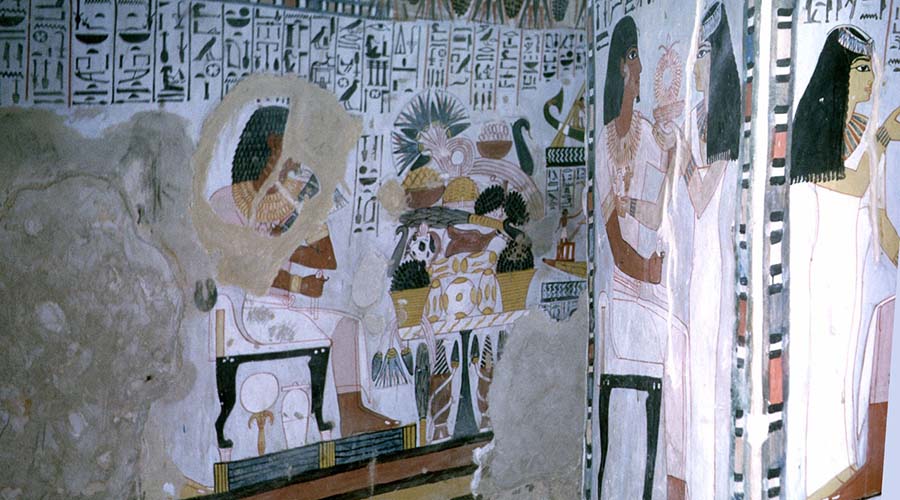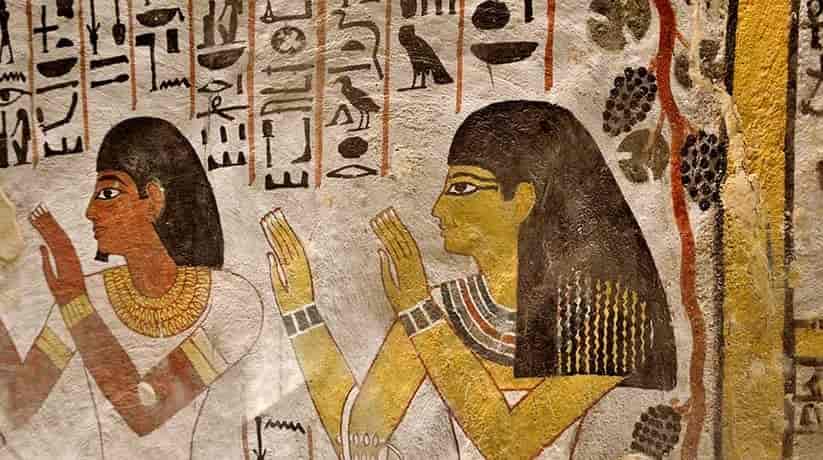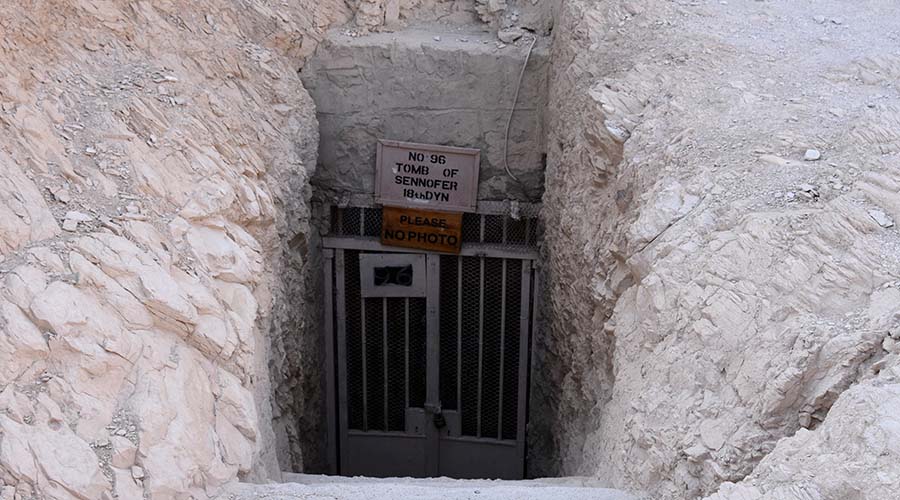Sennefer tomb Luxor TT 96 Egypt tours, prices, booking
Sennefer tomb Luxor (TT96) is famous for for its decorations. In addition, Sennefer well known as “The mayor of Thebes”. Sennefer tomb situated high on the southern hillside of Sheikh Abd El-Gurna. It is on the West Bank at Luxor (ancient Thebes). Sennefer tomb Luxor is in an area which known as the Tomb of the Nobles. Moreover, it is close to several other tombs of the time of Amenhotep II. This also include the well known tomb of Rekhmire (TT 100). The tomb overlooks the Ramesseum and the alluvial plain of the Nile. It takes the classic “T” plan of the private tombs. It also differs from other 18th Dynasty tombs in the amplitude of the burial chamber. In fact, both the antechamber and burial chamber decorated. The scenes within Sennefer tomb were the work of at least two different artists.
Sennefer Tomb Luxor opened since at least the Graeco-Roman Period. The tomb visited by Sir John Wilkinson sometime after 1821. In 1826, Robert Hay, part of who’s notebook is in the British Museum Library, copied many of the scenes. Howard Carter reported that the tomb “reopened” by Sir Robert Mond. It was in 1904. It should also noted that this may not have been Sennefer’s final resting place at all. Howard Carter speculated that he may have buried in tomb KV 42. It based on canopic jars, but all the evidence has not analyzed. If this is true, it might explain why no objects associated with Sennefer unearthed in Sennefer Tomb Luxor. Over the years there were many of attempts to rob Sennefer tomb Luxor of its paintings.
Further details about Sennefer tomb Luxor:
We find one such suspect scene in the Florence Museum. Other scenes restored. In 1994, the tombsuffered some damage due to a particularly violent storm. Since that time the walls completely conserved. It is with glass which installed to protect the images. Furthermore, the tomb, known by 19th century travelers as the “Tomb of the Vineyards”. It is because of the decorative theme of its ceiling. The ceiling of Sennefer tomb Luxor attests to the fact that he received a fair share of these proceeds. Sennefer’s tittles shown on the walls of his tomb. The titles varied, but the main one attached to his name is that of Mayor of Thebes.
In fact, Sennefer was in charge of the administration of the city. He also was responsible for works in the necropolis. Sennefer also was for upkeep of Amun’s temples, granaries, cattle, fields, gardens and orchards. His other titles included Chancellor to Amenhotep II. Titles also include “Overseer of the Granaries of Amen”. In fact, to hold such positions meant that he trusted and respected by the king. Sennefer thus so calls himself, in his tomb “Great Confidante of the Lord of the Two Lands”. Moreover, he also called himself “praised by the living god”and “of enduring favor”. Moreover, he also called himself “beloved one”. He also called himself “efficient and trustworthy servant of the Lord of the Two Lands”. Furthermore, he was efficient and loyal to his lord. He thus earned the king’s high esteem, as reflected in his final resting-place.
More details about the tomb:
Sennefer’s parents named Ahmose and Nub. Their names only found within the superstructure of the tomb. We know that he married to Meryt, who he refers to as beloved within Sennefer tomb Luxor. He maybe also married to as many as four other wives. They named Sentnefert, Senetnay. Moreover, they were both Royal Nurses to the king, Senetmi and Senetemiah. In fact, there is debate whether these were all different wives or different names for only one or two wives. They might all refer to Meryt or to Meryt and a second wife. Official documents record his marriage to Senetnay, who was almost the same as Meryt.
Senetnay also attested to by a statue from Karnak that is now in the Egyptian Museum in Cairo. In Sennefer tomb Luxor, Meryt depicted on the sides of several pillars. She presents gifts, as well as making the Pilgrimage to Abydos with her husband. It is while Senetnay found performing various duties. She also seen with him while making offerings to Amen. Furthermore, Sennefer also had at least three daughters. They included Mut-tuy. She seen in several scenes within the burial chamber of Sennefer tomb. Daughters also include Mutnefert, who shown on a statue in the Egyptian Museum in Cairo. The third daughter is Nefertiry, who is on a statue in the London Museum.
Further details about the tomb:
Sennefer tomb Luxor has a large and rectangular courtyard. It enclosed by a rough rock wall finished with plastered mud brick. Here, a superstructure, which referred to as a funerary chapel, damaged. It consists of a hall, passage and pillared inner hall. On the east wall of this room are three statue niches. It communicates with a single pillared hall. Yet the paintings in the funerary chapel are of even a higher quality. They are indeed much better than those within the substructure of Sennefer tomb. The most important of these indeed is a scene that shows Amenhotep II blessing the harvest. It is the earliest of only five such known scenes.
This superstructure has used to store artifacts from other tombs in the area. Moreover, it also used to store the treasures of Tutankhamen’s tomb. It is since 1905. Perhaps visitors will someday have access to this area. Sennefer tomb Luxor reached by way of a steep staircase. It is with 44 irregular rock cut steps, leading out of the yard facing the chapel, down twelve meters. These steps lead, after taking an elbow bend into an antechamber. They which in turn communicates thought a small doorway. Furthermore, It is with a four pillared burial chamber. In fact, both rooms plastered and have a pale bluish gray background, which was typical of this period.
More details about Sennefer tomb Luxor:
The remaining scenes in the antechamber indeed well preserved. The antechamber of Sennefer tomb Luxor measures 3.5 meters by 2.35 meters. Here, the staircase bends to the right. One presented with Sennefer sitting under a grape laden pergola. It is a theme which repeated in the whole of Sennefer tomb’s ceiling. Moreover, on the western wall we find Sennefer receiving offerings. They presented by priests led by one of his daughters. The consisting of linen tissues, torches, a foreleg of beef and bread. His daughter, Mut-tuy the “Singer of Amun”, offers him two necklaces and a heart amulet. Furthermore, on the eastern (right hand wall), the scene depicts the funerary entourage. It is with bearers presenting the tomb equipment.
These items include a large menat collar, leather sandals and two shawabti figures. They also include the funeral mask and a heart shaped amulet. Moreover, it painted blue to symbolize lapis lazuli. There are also a bed and Sennefer’s personal possessions which locked up in two small boxes. Beside the door to the burial chamber on the northern wall there is another scene. It also depicts the woman named Setneferet, “much beloved sister and singer of Amun”. She plays the sistrum while holding a menat necklace. Along with her deceased husband, depicted worshiping Osiris and Anubis. Osisris and Anubis are the two major deities of the afterlife. The short passage between the antechamber and burial chamber decorated. But the scenes damaged.
Further details about the tomb:
The burial chamber of Sennefer tomb Luxor itself indeed is cheerful, if one may say that about a tomb. In fact, Its irregular surfaced ceiling is spectacular. Its portrayal of vineyard grapes at the entrance. The ceiling and portrayal give way to a multicolored carpet of geometric designs. It provides an impression that one is standing under a tent. The pillars only enhance this perception. The decorative theme is complex and reveals the life of the deceased. It also reveals his wife Meryt in the after-world. Sennefer tomb’s walls painted in a precise order. It tells the story of the deceased’s journey through the afterlife. Moreover, it begins with the initial offerings to the gods. It ends with the deceased regenerated and his appearing in daylight.
The order of these scenes actually begins on the northwestern wall. From there, they proceed clockwise around Sennefer tomb Luxor. Here the first scene portrays Sennefer and Meryt. They make offerings to Osiris-Unnefer (Lord of the Holy Land, Price of Eternity). It is beside Hathor (Lady of the Western Necropolis). This scene in turn, followed by Sennefer’s funeral procession. It is where his sarcophagus hauled by four oxen and proceeded by servants. The servants carry the funeral equipment which locked up in wooden coffers. There are also offerings and procession accompanied by friends. They are besides to high ranking officials.
More details about Luxor Sennefer tomb:
Another scene, depicts the funerary rites. It including washing and cleansing the body of the deceased. It also includes the transportation of the canopic jars as well as other ceremonies. Turning the corner, we find on the northeast wall a double scene of offerings to Osiris. It is where the deceased and his wife found facing a well stocked table of food offerings. It is in front of which there are priests carrying torches and libations. These scenes also have accompanying offering formulas.
While most of the scenes are in precise order in Sennfer tomb, there are two scenes are out of order. The first portrays Sennefer and his wife worshiping Anubis and the resurrected Osiris. Osiris face painted a reddish (blood) color. The color used to represent the living. It followed by a river scene recalling the pilgrimage to Abydos. Moreover, it is a common occurrence in private tombs. It is in the holy city of Abydos that the traditional tomb of Osiris considered to locate. In fact, it was necessary for the deceased to make this trip in order for his soul. It is to judged by weighing it on a set of scales against the feather of Ma’at.
Further details about the tomb:
The boat that Sennefer and his wife travel aboard on the Nile is green. It symbolizing papyrus but also regeneration. They sit beneath a baldachin. It is while a priest performs a cleansing ceremony before leaving on their journey. Their bark pulled by a second, larger boat complete with helmsman, rowers and a captain. In a second register, they shown on the return journey back to the Thebean necropolis. This time with the lead boat depicting a sail.
On the next wall (southeast), the grape motif of the ceiling winds down around the next scene. It is where we find Sennefer and Meryt first depicted worshiping Osiris and Anubis. It followed by a scene from Chapter 151 of the Book of the Dead. Here, the deceased lies on his death bed. Anubis, the divine embalmer, accompanied by Isis on the right and Nephthys on his left. He attend to his mummy. Beneath the bed is Sennefer’s ba, or soul. It represented as a bird. In each corner of this scene are one of the four sons of Horus. They consist (clockwise) of Qebhsenuef, Duamutef, Imset and Hapy. In the lower part of this scene shown two shawabi figures. It is along with passages from Chapter 6 of the Book of the Dead.
More details about the tomb:
This text includes the magic formula. It allows the deceased to call upon the shawabti so that they undertake his labors in the Afterworld. At the far end of this same wall is another curious scene. It depicts Sennefer and his wife cleansed by water from a nemset-jar by a sem-priest. In fact, it is the most ancient representation. It is with the priest wearing his traditional leopard skin garment. Here one finds an ancient Greek graffito from an early tourist to Sennefer tomb Luxor. It appears on the left of a double heart scarab amulet worn around Sennefer’s neck. He holds a bouquet of lotus buds, while Meryt also holds lotus buds as well as her sistrum and menat.
Next to the chamber’s entrance, a depicted priest bringing libations and burns offerings. On the left front wall we discover a scene representing Sennefer and his wife. They seated on high backed chairs in a conventional attitude. Meryt’s hair tied with a band that adorned with a large lotus flower. Above the doorway is a double scene of Anubis as a black jackal crouching on a pylon shaped shrine. It is to either side of some lotus flowers. The Pillars within the burial chamber at Sennfer tom also decorated. On three sides, each of them portray Meryt offering lotus flowers and perfume ointments. She also offers food, myrrh, protecting amulets and linen bands. She also offers necklaces and a sistrum to her husband.
Further details about Sennefer tomb Luxor:
One exception is the southeast pillar where she stands before him. One one side of each pillar, the scenes vary. On the southwest pillar, the deceased and his wife are beneath a sycamore. It is with Sennefer sitting on a chair while Meryt sits on the floor at his feet. The deceased smells a lotus flower and holds a Sekhem scepter, symbol of power and authority. It is while in front of them is a table with three vessels containing beer and wrapped in lotus stems. On the northwest pillar depicted the “goddess of the sycamore”. They offering water to the couple surmounted by a portrayal of Anubis in canine form.
Entrance to the tomb:
Sennefer tomb Luxor is open 8 am to 4 pm in winter. A ticket for the tombs of Sennefer and Rekhmire can bought at the ticket office.

















